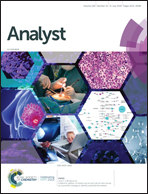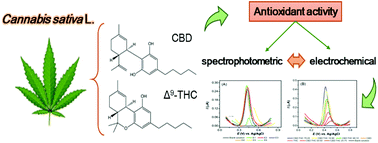
Tag Archives: THC
Probing the antioxidant activity of Δ9-tetrahydrocannabinol and cannabidiol in Cannabis sativa extracts.

The isolated cannabinoids, the different stoichiometric ratios of CBD and THC, and the natural extracts proved to have remarkable antioxidant properties in all the methods employed in this work.
The antioxidant activity of CBD and THC was compared against that of the well-defined antioxidants such as ascorbic acid (AA), resveratrol (Resv) and (-)-epigallocatechin-3-gallate (EGCG). Clear evidence of the synergistic and antagonistic effects between CBD and THC regarding to their antioxidant activities was observed.
Moreover, a good correlation was obtained between the optical and electrochemical methods, which proved that the reported experimental procedures can easily be adapted to determine the antioxidant activity of extracts from various Cannabis sativa species and related compounds.”
https://www.ncbi.nlm.nih.gov/pubmed/31318364
https://pubs.rsc.org/en/content/articlelanding/2019/AN/C9AN00890J#!divAbstract
Nabiximols for the Treatment of Cannabis Dependence: A Randomized Clinical Trial.
“This study demonstrates that cannabinoid agonist treatment, in this case using nabiximols, in combination with psychosocial interventions is a safe approach for reducing cannabis use among individuals with cannabis dependence who are seeking treatment.” https://www.ncbi.nlm.nih.gov/pubmed/31305874
https://jamanetwork.com/journals/jamainternalmedicine/fullarticle/2737918
“nabiximols: An herbal preparation containing a defined quantity of specific cannabinoids formulated for oromucosal spray administration with potential analgesic activity. Nabiximols contains a standardized extract of tetrahydrocannabinol (THC), the non-psychoactive cannabinoid cannabidiol (CBD), other minor cannabinoids, flavonoids, and terpenes from two cannabis plant varieties.” https://www.cancer.gov/publications/dictionaries/cancer-drug/def/nabiximols
“Cannabis treatment counters addiction: First study of its kind. Trial shows cannabis replacement therapy can be effective” https://www.sciencedaily.com/releases/2019/07/190715114247.htm
Model-based analysis on systemic availability of coadministered cannabinoids after controlled vaporised administration.

“The most important two medicinal cannabinoids are Δ9 -tetrahydrocannabinol (THC) and cannabidiol (CBD).
The results observed in this study are useful for guiding future pharmacokinetic studies of medicinal cannabinoids, and for development of dosing guidelines for medical use of cannabis in the ‘real world’ setting.”
Distinct Functions of Endogenous Cannabinoid System in Alcohol Abuse Disorders.

“Δ9-tetrahydrocannabinol (Δ9 -THC), the principal active component in Cannabis sativa extracts such as marijuana, participates in cell signaling by binding to cell surface receptors. CB1 receptors (CB1 s) are present in both inhibitory and excitatory presynaptic terminals. CB2 receptors (CB2 s) found in neuronal subpopulations in addition to microglial cells and astrocytes and are present in both pre- and postsynaptic terminals.
Subsequent to endocannabinoid (eCB) system discoveries, studies have suggested that alcohol alters the eCB system and that the eCB system plays a major role in the motivation to abuse alcohol.
Preclinical studies have provided evidence that chronic alcohol consumption modulates eCBs and CB1 expression in brain addiction circuits. In addition, studies have further established the distinct function of the eCB system in the development of fetal alcohol spectrum disorders. This review provides a recent and comprehensive assessment of the literature related to the function of the eCB system in alcohol abuse disorders.”
https://www.ncbi.nlm.nih.gov/pubmed/31265740
https://bpspubs.onlinelibrary.wiley.com/doi/abs/10.1111/bph.14780
“Cannabis and Alcohol: From Basic Science to Public Policy.” https://www.ncbi.nlm.nih.gov/pubmed/31265135
Cannabis use in active athletes: Behaviors related to subjective effects.

“Athletes who use a combination of THC and CBD exhibited the most benefit to well-being and calm with minimal adverse effects.” https://www.ncbi.nlm.nih.gov/pubmed/31251769
https://journals.plos.org/plosone/article?id=10.1371/journal.pone.0218998
The heterogeneity and complexity of Cannabis extracts as antitumor agents

“The Cannabis plant contains over 100 phytocannabinoids and hundreds of other components. The biological effects and interplay of these Cannabis compounds are not fully understood and yet influence the plant’s therapeutic effects.
Here we assessed the antitumor effects of whole Cannabis extracts, which contained significant amounts of differing phytocannabinoids, on different cancer lines from various tumor origins.
Our results show that specific Cannabis extracts impaired the survival and proliferation of cancer cell lines as well as induced apoptosis.
Our findings showed that pure (-)-Δ9–trans-tetrahydrocannabinol (Δ9-THC) did not produce the same effects on these cell lines as the whole Cannabis extracts. Furthermore, Cannabis extracts with similar amounts of Δ9-THC produced significantly different effects on the survival of specific cancer cells.
In addition, we demonstrated that specific Cannabis extracts may selectively and differentially affect cancer cells and differing cancer cell lines from the same organ origin. We also found that cannabimimetic receptors were differentially expressed among various cancer cell lines and suggest that this receptor diversity may contribute to the heterogeneous effects produced by the differing Cannabis extracts on each cell line.
Our overall findings indicate that the effect of a Cannabis extract on a specific cancer cell line relies on the extract’s composition as well as on certain characteristics of the targeted cells.”
http://www.oncotarget.com/index.php?journal=oncotarget&page=article&op=view&path[]=26983
“Many previous reports highlight and demonstrate the anti-tumor effects of cannabinoids. In the last decade, accumulating evidence has indicated that phytocannabinoids might have antitumor properties. A number of in vitro and in vivo studies have demonstrated the effects of phytocannabinoids on tumor progression by interrupting several characteristic features of cancer. These studies suggest that specific cannabinoids such as Δ9-THC and CBD induce apoptosis and inhibit proliferation in various cancer cell lines.”
Cannabinoids reduce hyperalgesia and inflammation via interaction with peripheral CB1 receptors.

“Central antinociceptive effects of cannabinoids have been well documented.
Our results indicate that cannabinoids produce antihyperalgesia via interaction with a peripheral CB1 receptor.
This hypothesis is supported by the finding that anandamide inhibited capsaicin-evoked release of calcitonin gene-related peptide from isolated hindpaw skin.
Collectively, these results indicate that cannabinoids reduce inflammation via interaction with a peripheral CB1 receptor.”
“The Endocannabinoid System and Pain. Cannabis has been used for more than twelve thousand years and for many different purposes (i.e. fiber, medicinal, recreational). However, the endocannabinoid signaling system has only recently been the focus of medical research and considered a potential therapeutic target. Cannabinoid receptors and their endogenous ligands are present at supraspinal, spinal and peripheral levels. Cannabinoids suppress behavioral responses to noxious stimulation and suppress nociceptive processing through activation of cannabinoid CB1 and CB2 receptor subtypes. These studies suggest that manipulation of peripheral endocannabinoids may be promising strategy for the management of pain.”
https://www.ncbi.nlm.nih.gov/pmc/articles/PMC2834283/
Cannabis and cannabinoids on treatment of inflammation: a patent review

The inflammatory process is a physiological response to a vast number harmful stimulus that takes place in order to restore homeostasis. Many drugs used in pharmacotherapy are effective to control inflammatory responses, however there is a range of adverse effects attributed to steroidal and non-steroidal anti-inflammatory drugs (NSAIDs).
Nabilone administration in refractory chronic diarrhea: a case series


